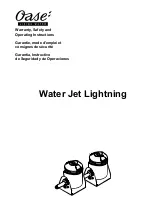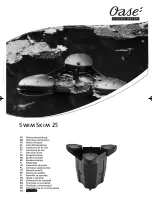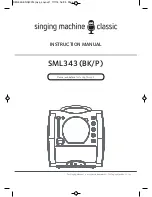
5-3
Chapter 5
W
elding Operation
C
HECK
BEFORE
W
ELDING
W
ELDING
O
PERATION
C
HAPTER
5
4
The voltage detection cable should be
adequately wired.
The voltage detection cables at the base metal side and the torch side
should be wired along each other.
Keep the voltage detection cable (base metal side) at least 3.9" (10 cm)
away from the cable at the base metal side.
5
The voltage detection cable should not be
damaged.
If any damage is suspected, use a tester to measure the resistance
between the voltage detection cables.
When the resistance is 0.01
Ω
or more, replace the voltage detection
cable with a new one.
6
The contact part of jig and welding work
piece should not be painted.
Painted contact part could cause increased contact resistance, resulting
in decrease in arc voltage. Polish the painted contact part using a grinder
to expose the metal face.
7
The contact part of jig and welding work
piece should be free from unevenness due
to influence of burn through, spatter, or
aging deterioration.
Polish the surface of the jig using a grinder so that the welding workpiece
and the jig can fully contact each other.
8
The mixing ratio of shielding gas should be
adequate.
CO
2
High CO
2
- concentration could increase the spatter generation.
For shield gas, follow the mixing ratio as follows:
CO
2
gas
:
Carbon dioxide (CO
2
) 100 %
MAG gas
:
Argon (Ar) 80 % + Carbon dioxide (CO
2
) 20 %
MIG gas
(Stainless)
-
:
Argon (Ar) 98 % + Oxygen (O
2
) 2 %
MIG gas
(Aluminum/
Aluminum bronze
/Silicon bronze)
:
Argon (Ar) 100 %
9 The shielding gas should be correctly mixed.
Use a mixer. If welding is unstable, use pre-mix gas to check if the welding
condition is improved.
10
The flow rate of shielding gas should be
adequate.
Ensure the adequate shield gas flow rate as follows:
CO
2
/MAG gas
MIG gas
:
21 to 53 CFH (10 to 25 L/min)
:
32 to 53 CFH (15 to 25 L/min)
11
When the shield gas is mixed, each gas
pressure should be the same.
Set pressures of the respective gas to the same level.
12
Oil or other dirt should not be adhered on
the welding wire.
Consider a measure to wipe off the dirt.
13
In the CO
2
- and MAG welding, the particle
diameter of wire tip at the welding
completion should not excessively be large
or small.
Adjust anti-stick voltage so that the wire tip particle size becomes 1.2 to
1.5 times of the wire diameter. If the particle size is smaller than the
above, set the anti-stick voltage to a higher value, whereas if the particle
size is larger than the above, set the anti-stick voltage to a lower value.
14
At start point of welding, the tip of welding
wire and the welding workpiece should not
be contacted.
(When using a robot, operate several times
with "welding OFF" and confirm that the
welding wire and the welding workpiece do
not contact each other.)
If the wire tip contacts with the welding workpiece, set anti-stick voltage to
a higher value to increase meltage of the welding wire at the end of
welding.
If anti-stick voltage is set to a value higher than the appropriate range, the
wire tip particle size becomes excessively large, resulting in poor start
performance of the next welding.
15
The tip of the welding torch should not be
worn.
Visually check the hole diameter of the tip. If it is 1.2 times or larger than
the hole diameter of a new tip, or when the tip is discolored, replace it with
a new one.
16
In wire feeding, pressure roll should not be
idled and the wire reel should rotate
smoothly.
Adjust the pressure level of wire feeder. If it is not improved, check for
other factor that generates overload on wire feeding. (
See parameter
12, 17, 18)
17 The groove of feed roll should not be dirty.
Clean the dirty groove with a wiry tool.
Check parameter
Countermeasures
Check
















































